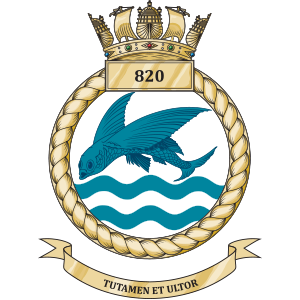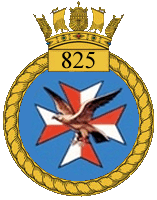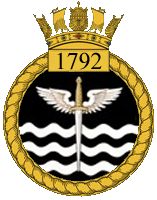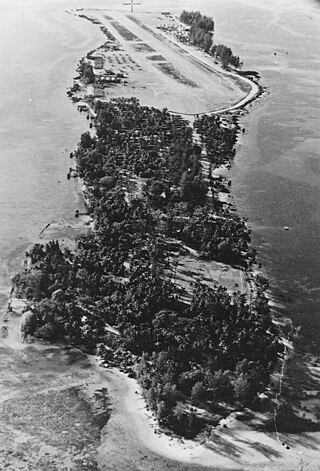
The 14th Carrier Air Group was an aircraft carrier air group of the Royal Navy's Fleet Air Arm. It was initially formed in June 1945, for service in the British Pacific Fleet, until disbanding in July 1946. The group was embarked on HMS Colossus (R15).

Royal Air Force Kai Tak or more commonly RAF Kai Tak is a former Royal Air Force station situated in Hong Kong, at Kai Tak Airport, Kowloon. It was established by the Royal Air Force (RAF) in 1927 and used for seaplanes. The RAF flight operated a few land based aircraft as well as having spare aircraft for naval units.

The Sembawang Air Base is a military airbase of the Republic of Singapore Air Force (RSAF) located at Sembawang, in the northern part of Singapore. The base motto is Swift and Resolute.

816 Naval Air Squadron was a Fleet Air Arm (FAA) naval air squadron of the United Kingdom’s Royal Navy (RN) which formed at the start of the Second World War. It was first formed in March 1939, aboard the carrier HMS Furious, to support anti-submarine and strike missions for North Atlantic convoys. It conducted the first aerial torpedo attack of the war during the Norwegian Campaign in April 1940. An attack on the German battlecruiser Scharnhorst was attempted in September 1940, and on the squadron joined RAF Coastal Command in March 1941 for operations along the Dutch and French coasts. The squadron re-embarked on HMS Furious in June 1941 to provide anti-submarine cover while RAF aircraft were sent to Malta. On the return trip, it transferred to HMS Ark Royal and stayed with her until she sank in November 1941
HMS Nabbington, was a Royal Navy (RN), Mobile Operational Naval Air Base (MONAB), that was established at the Royal Australian Air Force (RAAF) base RAAF Nowra at Nowra, New South Wales, in Australia during the final stages of the Second World War. HMS Nabbington was also known as MONAB I and Royal Naval Air Station Nowra.

820 Naval Air Squadron is a Royal Navy Fleet Air Arm carrier-based squadron flying the AgustaWestland Merlin HM2 in Anti-Submarine and Airborne Early Warning (AEW) roles from RNAS Culdrose.
821 Naval Air Squadron was a Royal Navy Fleet Air Arm carrier based squadron formed on 3 April 1933 with the transferral and amalgamation of the Fairey III aircraft from 446 and half of 455 Flight Flights Royal Air Force to the newly formed Fleet Air Arm of the Royal Air Force. The squadron operated during the Second World War.
810 Naval Air Squadron was a Royal Navy Fleet Air Arm carrier based squadron formed on 3 April 1933 with the amalgamation of the 12 Blackburn Dart aircraft from 463 and 44 Flight Flights Royal Air Force to the Fleet Air Arm. The squadron saw action during the Second World War, the Suez Crisis and the Korean War.

825 Naval Air Squadron is a Royal Navy Fleet Air Arm Naval Air Squadron which was re-commissioned on 10 October 2014 and currently flies the AgustaWestland Wildcat HMA2.

813 Naval Air Squadron, was a Fleet Air Arm (FAA) naval air squadron of the United Kingdom’s Royal Navy (RN) during World War II and again post-war. It initially operated Swordfish Mk Is from the aircraft carrier Illustrious and took part in the successful raid on Taranto in November 1940.

HM Prison Ford is a Category D men's prison, located at Ford, in West Sussex, England, near Arundel and Littlehampton. The prison is operated by His Majesty's Prison Service.
823 Naval Air Squadron was a Fleet Air Arm aircraft squadron before and during World War II.

826 Naval Air Squadron was a Fleet Air Arm aircraft squadron formed during World War II which has been reformed several times since then until last disbanded in 1993.

1792 Naval Air Squadron was a Fleet Air Arm (FAA) naval air squadron of the United Kingdom’s Royal Navy (RN). It was formed in May 1945 at HMS Daedalus, RNAS Lee-on-Solent as a Night Fighter squadron. It was equipped with the Fairey Firefly NF.Mk I night fighter. The squadron joined HMS Ocean in December for service in the Mediterranean. On return to the UK the squadron was disbanded in April 1946.

745 Naval Air Squadron was a Fleet Air Arm (FAA) naval air squadron of the United Kingdom’s Royal Navy (RN). It was initially active from 1943 to 1945 as a Telegraphist Air Gunner Training squadron, part of No.2 Telegraphist Air Gunner School based at RN Air Section Yarmouth, Nova Scotia, Canada. It reformed in April 1956 at HMS Gannet, RNAS Eglinton, Northern Ireland, as a Radar Jamming Trials Unit. It operated with four modified Grumman Avenger aircraft, undertaking a trials evaluation of the 'Orange Harvest' radar warning receiver equipment, disbanding in November 1957.

768 Naval Air Squadron was a Fleet Air Arm (FAA) naval air squadron of the United Kingdom’s Royal Navy (RN). It last disbanded at HMS Gannet, RNAS Eglinton, Northern Ireland, in March 1949, having been formed as a Deck Landing Control Officer Training Squadron, in December 1948, to ensure one American-style signal trained DLCO could be located at every FAA station. It first formed as part of the Deck Landing Training School at HMS Condor, RNAS Arbroath, in January 1941, as a Deck Landing Training Squadron. Advanced training was in HMS Argus, for which a detachment was maintained at HMS Landrail, RNAS Machrihanish, where it wholly moved to in March 1943. September saw a move to RAF Heathfield, Ayr, followed by a further move to HMS Sanderling, RNAS Abbotsinch in January 1944. Training used escort carriers on the Firth of Clyde and a detachment was maintained at (Heathfield)Ayr throughout this period, with the squadron returning there in July 1945, at this time HMS Wagtail, RNAS Ayr. In August the squadron moved to HMS Corncrake, RNAS Ballyhalbert in Northern Ireland but then in October it joined up with the Deck Landing School at HMS Peewit, RNAS East Haven, Scotland, where it disbanded in April 1946.

Royal Naval Air Station Twatt, is a former military airfield, located near Twatt, Orkney, Scotland, of the Royal Navy. It was built by the Admiralty and was commissioned on 1 April 1941. On 1 January 1942 it became an independent command as HMS Tern. The airbase was designed to provide accommodation for disembarked Front-Line squadrons and accommodation for disembarked Ship's Flight Aircraft and was home to the Home Fleet Fleet Requirements Unit, 771 Naval Air Squadron.

HMS Nabaron was a Royal Navy (RN) Mobile Operational Naval Air Base (MONAB) which was situated at the United States Navy (USN) airfield NAS Ponam Airfield on Ponam Island, Admiralty Islands in Papua New Guinea, which had been transferred to RN on loan. HMS Nabaron was also known as MONAB IV and Royal Naval Air Station Ponam.
HMS Nabstock was a Royal Navy (RN), Mobile Operational Naval Air Base (MONAB) which was initially located at the Royal Australian Air Force (RAAF) airfield RAAF Maryborough situated in Maryborough, Queensland. HMS Nabstock was also known as MONAB VI and Royal Naval Air Station Maryborough, between June and November 1945. It decommissioned and moved to RAAF Station Schofields located at Schofields, New South Wales, where MONAB VI recommissioned as HMS Nabstock and known here as Royal Naval Air Station Schofields until June 1946.















